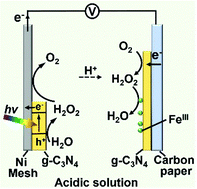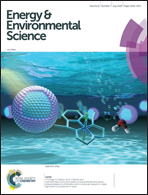A g-C3N4 based photoelectrochemical cell using O2/H2O redox couples†
Abstract
Utilization of solar energy for electric power production provides a practical approach for partially solving the energy crisis and at the same time reducing environmental pollution. Here, we demonstrate a photoelectrochemical cell based on a g-C3N4 photocatalyst using O2/H2O redox couples, fabricated with iron(III) phthalocyaninate [FeIII(Pc)Cl] mixed with g-C3N4 sprayed on carbon paper as the cathode and a nickel mesh (Ni mesh) coated with g-C3N4 as the anode. Under irradiation, g-C3N4 in the anode harvests photons and produces excited electrons and holes. The produced electrons transfer to the cathode by an external circuit and reduce O2 near the cathode to H2O2, electrochemically catalyzed by g-C3N4 through two-electron, two-proton processes, while the produced H2O2 is further reduced by [FeIII(Pc)Cl] to H2O. The generated holes in the anode oxidize H2O to H2O2 by two-electron, two-proton processes. The formed H2O2 can further be oxidized by the Ni mesh with O2 generation. This photoelectrochemical cell achieves an open-circuit voltage of 0.91 V under AM 1.5G solar light (1 sun, 100 mW cm−2) in 0.1 M HCl under air atmosphere. The total solar to electric power efficiency of this cell is 0.146%. Additionally this cell can generate and store H2O2 (chemical energy) with the electrodes disconnected under light, where water oxidation photocatalyzed by g-C3N4 will occur on both the electrodes. By connecting the electrodes, the cell can be operated as a fuel cell using H2O2 as the fuel in the absence of sunlight with an area-specific capacity of 350 mC cm−2 and a mass-specific capacity of 237 C g−1.



 Please wait while we load your content...
Please wait while we load your content...